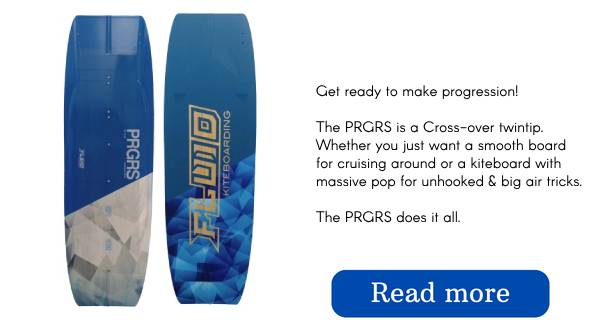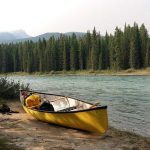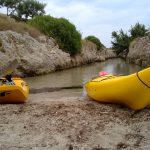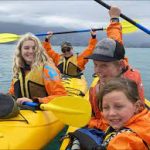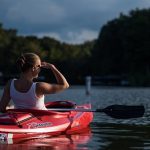Keeping communication lines open between members of your kayaking or canoeing group, whether you’re on a day trip or a longer one, makes your outing safer.
Different types of signaling devices are available for purchase, and many of them can be used to communicate with your paddling partners as well as other people or locations outside of your immediate group, like other boat operators or people on land.
The following are the minimum recommended devices for any trip:
Safety equipment
If you want to stay safe while enjoying the water, then you should take some safety precautions.
Although our seas, lakes, and rivers are beautiful, they can be dangerous as well.
This is why it is essential to have a few safety items on your canoe or kayak at all times. You never know when you might need them.
It is important to ensure that your vessel is compliant with current regulations by checking which pieces of safety equipment are required by law before setting sail.
If you want to further protect yourself from harm, take some additional steps such as making sure everyone is wearing a life jacket.
List of Safety Equipment is Required on Every Canoe and Kayak
- Personal Flotation Device
- Communications
- Signals
- Whistles and horns
- Flares
- Flashlights
- Navigational Lights
- Rescue equipment
- Visual Distress Signals (VDS)
Flotation Device
This flotation device is simple to use and will keep you afloat if you end up capsizing.
The flotation device should be the first thing you think about using if you have an accident.
There are many different uses for your personal flotation device (PFD), but in most states it is legally required to wear one in most bodies of water.
A personal flotation device, or PFD, is an important piece of safety gear to wear whenever you are in or near the water.
You should bring a waterproof bag on your kayaking or canoeing trips.
Why Carry Devices?
“CLAP” stands for communication and line-of-sight. These are the first two letters of the acronym. It is essential to be able to communicate and see other paddlers so you are aware of what they are doing and can help if needed.
Think about driving. If you can’t see the car’s turn signals or tail lights, you can’t tell if it’s slowing down quickly to make a turn. You might hit it if you’re driving closely behind it. The driver of the other car is signaling to you that he’s about to brake by turning on his tail lights.
When you see a car on the side of the road with the hood up, it’s likely that the driver needs help. Different types of communication help keep the road safe for users.
Signaling devices are a great way to communicate with people when paddling. By using them, you can let others know what your intentions are and make sure that everyone is safe. By maintaining communication between paddlers, you will be aware of their intentions and when they need assistance.
Using the appropriate signaling devices, you can also communicate with other boaters. wearing a life jacket and carrying a whistle will help you stay safe when you’re out on the water, and also help you signal for help if you need it.
Types of Devices
Signalling devices can be divided into several groups. The two most basic are visual or audio. Visual devices can include anything from a hand signal to a flare with a parachute.
Audio devices can range from simple devices such as whistles to more complicated devices such as VHF radios.
There are two types of these devices: those within your group and those outside your group.
Signalling Devices for Paddling Within Your Group
There are three ways to signal others in your group: with a whistle, a paddle, or your hand. You can also add a VHF radio.
The sound of a whistle can often be heard over waves and wind, but not always. Before using a whistle to signal others in your group, agree on what the different blasts will mean. One short blast from a whistle could mean “look at me,” while two blasts could mean “stop and look at me.”
If someone blows a continuous stream of air through the whistle, this could be a sign that they need help. When purchasing a whistle, it is best to choose one without a pea inside, as these can become stuck when wet and cause the whistle to fail.
ACR’s WW-3 Res-Q Whistle is loud and works well. Tie the cord to your lifevest in a short length. Keep the cord short enough that it couldn’t wrap around your neck and choke you if you fell.
A paddle can be used for signaling various things, but commonly, paddlers would establish signals for meaning turn left, turn right, stop, paddle forward, paddle backward, and come here.
It’s a good idea to discuss what measuring system you’re going to use before starting a project. Although there are standards, everyone may not be using the same standards.
One way to propel yourself through the water is by using your hands in a similar way to how you would use a paddle. Agree to the signals before launching.
Although you may not agree to use hand signals, many of them are easy to understand. Make sure your paddling partners can see you by exaggeration your hand signals.
VHF radio: We’ve covered How to Use a VHF Radio and How to Call Mayday before. A VHF radio is a great way to stay in touch with your fellow paddlers when you can’t see them.
It might be a good idea to establish some guidelines for when it’s okay to have your radio on while paddling. For example, you could turn it on when you’re out of view, or check it every hour.
Signalling Devices for Communicating Outside Your Group
In non-emergency situations, white flares are used to catch the attention of another boater.
Fog horns are used to signal your position when paddling in the fog. They give a low tone. You should blow a long blast every two minutes when you are moving in fog. There are two types of fog horns that can be useful for kayakers and canoeists.
The first is a small, hard-to-find whistle-style horn. This type of air horn uses compressed air to blast the signal.
A whistle can be used to communicate with other boaters by making lots of short blasts. One should not expect a whistle to be louder than an engine or to be heard from far away.
If you have a VHF radio, you may be able to get in contact with other boats or the Coast Guard near you. We’ve discussed how to use a VHF radio and how to make a mayday call previously. I like Icom’s radios and have a M72.
Additional Emergency Signalling Devices
Dyeing the water around you can help rescuers pinpoint your location.
The wind catches the banner and pulls it downstream, providing a drag to help keep the swimmers from being pulled away too fast. The text describes streamers, which are banners that are released in the water in order to provide resistance and keep swimmers from being pulled away too fast.
As the sun sets, it creates a bright orange or red visual cue. You are the exclamation point at the end of the sentence.
Personal locator beacons (PLBs) are distress signals that can be used to alert and locate people. Once you activate the PLB, it triggers a rescue. This PLB from ACR is incredibly lightweight, lasting up to 24 hours on its battery in an emergency. It’s equipped with a GPS and a strobe light for quick positioning and visibility.
The ideal situation would be to wear a PLB on your lifevest, so that you would always have it with you in the event that you lose your boat and equipment.
Personal Alarms
It’s critical to be able to get assistance when you run into any issues.
The best way to do this is to use both sight and sound.
Since childhood, we have been taught that we should offer help if someone appears to be in need. There are many personal alarms available to help people in an emergency situation.
Ships that are under 60 feet long are required to have a sound-generating device by the Coast Guard.
An effective sound-producing equipment must be installed in boats.
Whistles or horns
In many US states, you are required to have a whistle and horn on your boat.
Be sure to check your local code to ensure you are compliant. whistles and horns should be used such that the sound is loud enough to reach the beach clearly and should attract attention.
Horns and whistles are much better than shouting for help because you can keep blowing them for a long time.
A sharp blast from a whistle is very distinctive when you’re listening for it on the shoreline.
Flares
If you travel, you must have over a nautical mile of distance between you and the water.
Flares stand out because they are visually attention-grabbing, but it’s always best to have more than one so you never have to rely on just one to get the job done.
Flashlights
The lantern is not only beautiful to help you see in the darkness, but it’s also a great way to signal over long distances.
Using light for communication has been done for centuries, for example with lighthouses and by smugglers.
A canoe usually has waterproof lights on both sides, but most paddlers only bring a small flashlight. This is because it can be easily transferred from one side of the canoe to the other.
It’s important for all seafarers to identify their port and starboard when they are out on the water during the hours of dusk and dawn.
Rescue Equipment
BOATERS MUST HAVE THE FOLLOWING ITEMS ON THEIR VESSEL, REGARDLESS OF WHETHER IT IS A KAYAK, CANOE, OR OTHER TYPE OF BOAT:
Other kayakers will be able to tow and lift you back to safety with such items.
It is recommended that you have a device to help you get back into the boat, like a stirrup or sling, so it is much easier to get into the boat.
It is wise to be aware of nautical laws. it is important to know when to stay inside or outside of a lifebuoy, as well as the right of way laws for all vessels. I find this book on Amazon to be very helpful when it comes to understanding the Nautical “Rules of the Road.”
Nautical Visual Distress Signals (VDS)
If you decide to use a VDS, Paddlers may use distress signals, known as visual distress signals (VDSs), to attract attention in an emergency. If you decide to use a VDS, be aware that
There are various types of signals. Some signals are for night use and some are for day use. Flares have been used for years as a way to signal for help or attention.
Paddleboards, kayaks, and canoes are not required to carry visual distress signals. You might want to bring one or more of them just in case.
You are required to have a VDS if you plan to be on the water at night.
The VDS below is available from Amazon and will cover you for all times of day.
Are Lifejackets Required For Kayaking?
Paddlers must carry a personal flotation device while in a kayak or self-propelled boat.
Paddlers are required to wear lifejackets by the Coast Guard when they are in or on the water. Any vessel, including a kayak, that is operating in U.S. waters must have a floatation device on board as required by Coast Guard Rule #16.
Be aware of safety and know your parameters.
Around one-quarter of all fatalities reported among people who paddle involve alcohol.
Conclusion
If you are still unsure what type of safety equipment is required on every canoe and kayak, here is a list of the most common items. Here’s a quick synopsis.
Every canoe and kayak should be equipped with a lifejacket, a towing line for other paddlers, and an emergency strap system.
The best type of PFD is one that can be easily switched from one side to another, but it is just as important to remember to bring day and night signals when out on the water at dusk or after dark.
Remember not to drink alcohol if you’re going to be kayaking or canoeing, or engaging in any other water activities. This is because 25% of reported deaths were due to alcohol consumption.
Contact us if you need any assistance and we will respond as soon as possible.
